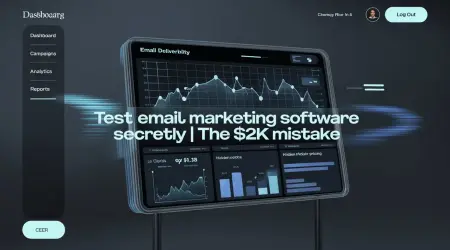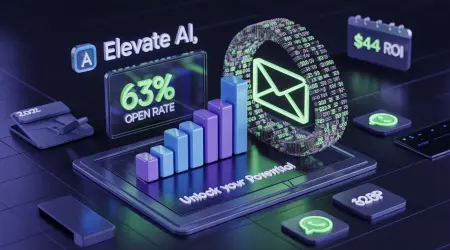
Get a Free Temp Mail Address | Protect Privacy & Unlock Student Discounts
Temp Mail USA provides enhanced email encryption for disposable communications, significantly reducing your exposure to data breaches. Our free temporary addresses act as protective shields between your primary inbox and registration spam, phishing attempts, and marketing trackers. By generating instant anonymous emails that leave minimal digital footprints, you maintain inbox hygiene while preventing identity leakage during online signups. Over 500K users trust our solution for secure course registrations, student discount verifications, and spam-free interactions – all without compromising your real email's security.

AI Privacy Risks in 2026: How to Stop Data Brokers & AI Scraping
If you're looking for how to remove your personal information online, you're already aware of the digital footprint we all leave behind. This guide will show you how, but first, it's crucial to understand the new, powerful forces making this essential in 2026: Artificial Intelligence and the data broker industry. Here’s how they work and the steps you can take to protect yourself
It's amazing how artificial intelligence has become such a fundamental part of our digital world. It's there when your streaming service suggests a perfect song you've never heard before, and it's there helping draft complex legal documents. AI systems - especially generative AI and large language models - are now deeply integrated into how we work, communicate, and share information. Look, while all this tech stuff feels pretty cool on the surface, let’s be real—our privacy is basically circling the drain these days. Every new app or gadget just seems like another excuse for someone to poke around in your business. Kinda messed up, honestly.
Let's be real for a second. That random comment you dropped on a blog post? That semi-professional update you shared on LinkedIn? By 2026, assume none of it is just for human eyes anymore. Your public words are being hoovered up, fed into AI systems, and used to train algorithms—usually without your awareness or consent.
And it gets creepier. These systems don't just collect your data. They learn from it. You know that random comment you left on some website years ago? Yeah, that one. Well, it's not forgotten. AI systems are now connecting those digital breadcrumbs—linking that old opinion to your recent posts, your likes, your shares—and sketching a portrait of you that you never intended to share publicly. This isn't some episode of Black Mirror. This is real, and it’s happening today. It’s no longer just about storing your data—it’s about algorithms reading between the lines, guessing what you didn’t say, and sometimes even spilling your secrets. Your online presence isn’t just being stored… it’s being studied. And honestly? That should make us all a little nervous.
This guide will help you cut through all the technical confusion and give you practical understanding of how AI affects data protection, what risks are emerging in 2026, what regulations are trying to manage this new landscape, and most importantly - what you can actually do to protect yourself.
Based on verified research, recent legal developments, and technical insights from 2025, this article provides a human perspective on one of today's most urgent challenges: finding the right balance between AI's incredible capabilities and our fundamental right to privacy.
Let's start with how AI models actually work - the training data, scraping process, and why they sometimes "hallucinate" information.
Here's the thing about those powerful AI models you keep hearing about—the GPT-6s, the Claudes, the Geminis: they aren't actually "thinking." They don't "get" things the way people do. Instead, they're like insanely advanced autocomplete tools. They've digested mountains of text from all over the internet, and they’ve gotten scarily good at spotting what word usually comes next. So when they write a smooth-sounding paragraph or answer your question, it’s not coming from understanding—it’s coming from pattern matching on a truly massive scale.
The AI training process doesn't work like human learning. It follows a multi-stage pipeline that begins with data collection through web scraping, where automated bots gather publicly available content from across the internet.
Grounded in verified research, legal developments, and technical insights from 2025, this article offers a human-written, deeply optimized look at one of the most urgent issues of the decade: balancing the power of AI with the right to privacy.
How AI Models Work: Training Data, Scraping, and Hallucination
Alright, here’s the deal with those fancy AI models: you gotta peek behind the curtain to really get the privacy drama. The secret sauce? Loads and loads of data—stuff scraped straight off the internet, mostly without asking anyone’s permission (oops). Yeah, LLMs like GPT-6, Claude 4, Gemini Ultra—all of 'em—they're not smart in the “thinking” way. No little robots pondering the meaning of life over here.
They're basically souped-up parrots with a calculator: churning through chunks of text, learning patterns, and then spitting back super-convincing stuff. They don’t know a thing, honestly. They just get really, REALLY good at guessing what should come next in a sentence after memorizing a bazillion examples.
The AI Training Pipeline
AI doesn’t “learn” in the human sense. It’s trained through a multi-stage pipeline:
Data Collection via Web Scraping
Picture this: AI companies send out digital scouts—bots with names like GPTBot, CCBot, and Google-Extended—that constantly roam the public corners of the internet. They’re not just browsing. They’re actively collecting: your forum posts, blog thoughts, news comments, code snippets, even metadata. Nothing public is off-limits.
And here’s what makes it different from Google: while search engines index the web to help you find things, AI bots are gathering all this material to actually learn from it. They’re not building a map—they’re building a brain, and your public writing is part of the training diet.
Model Training on Massive Datasets
Scraped data is preprocessed, cleaned, and fed into deep neural networks—typically transformer architectures—where the model learns to predict the next word in a sequence. This requires petabytes of data and thousands of GPU hours [2].
Fine-Tuning and Alignment
Once the basic training’s outta the way, models get another round in the ring—fine-tuning. You might’ve heard about stuff like RLHF (that’s Reinforcement Learning from Human Feedback, yeah, mouthful) and RAIF (AI Feedback). Basically, it’s humans (sometimes even other AIs, go figure) saying, “Hey, do better!” Helps the thing spit out less nonsense, play nicer with people, and actually be useful. Wild, right?
Inference Phase: When AI Generates Content
Once deployed, the model enters inference mode—generating responses based on learned patterns. But because it doesn’t “understand” context, it sometimes generates false or misleading content. This is known as AI hallucination.
What Is AI Hallucination?
AI hallucination occurs when a model generates factually incorrect or fabricated information with high confidence. For example:
- Citing a scientific study that doesn’t exist.
- Claiming you posted on a blog you’ve never visited.
- Inventing legal precedents or medical advice.
While hallucination is often seen as a quirky flaw, it reveals a deeper issue: AI models store and regurgitate training data without comprehension[2]. This leads directly to one of the most dangerous privacy threats—data memorization.
The Emerging Privacy Risks of Generative AI
Let’s be real—AI isn’t just playing chess with your data anymore. It’s out there, wild and unchecked, poking holes in your privacy like it’s got something to prove. By 2026? Forget what’s “theoretical.” We’ve got receipts. The dangers are legit, in-your-face, and getting worse by the minute.
Data Memorization & Leakage: When AI Remembers Your Secrets
Data memorization is the phenomenon where an AI model reproduces verbatim or near-verbatim snippets from its training data. This isn’t a bug—it’s a side effect of how models are trained.
A 2025 study published on arXiv found that deeper layers of transformer models—particularly attention modules—are primarily responsible for memorization, while earlier layers focus on generalization and reasoning [2]. That means the more complex the model, the more likely it is to “remember” sensitive content.
Real-World Examples of Data Leakage
- In 2025, researchers successfully extracted API keys, internal emails, and private messages from LLMs by crafting adversarial prompts[19].
- OpenAI acknowledged that GPT-4 had occasionally reproduced training data, including personal contact information, when prompted in specific ways [20].
- A GitHub comment containing a temporary password for a startup’s server was later regurgitated by an AI when queried about “common dev ops mistakes”[17].
This raises serious ethical and legal questions: if your data was scraped and memorized without consent, can you demand its removal?
The answer, for now, is complicated. While the EU AI Act mandates transparency in training data (more on that later), it doesn’t guarantee the right to erasure from model memory.
Why Memorization Happens
Memorization occurs when:
- A data point is unique or appears repeatedly in training data.
- The model is overfitted—trained too much on a narrow dataset.
- The prompt triggers a rare or sensitive pattern [23].
Mitigation efforts include:
- Output filtering and redaction layers.
- Data deduplication before training.
- Pruning model parameters to reduce memorization [21].
But these are imperfect. As long as AI is trained on public internet data, the risk of leakage remains.
Inferential Attacks: The Silent Threat to Your Privacy
Even if your data isn’t directly memorized, it can still be exposed through inferential attacks—where AI is used to deduce sensitive information from seemingly harmless inputs.
These attacks exploit the fact that AI models, even when they don’t store raw data, retain statistical patterns that can be reverse-engineered.
Two Common Types of Inferential Attacks
Membership Inference Attacks
An attacker queries an AI model to determine whether a specific individual’s data was part of the training set. For example:
- If an AI gives highly confident medical diagnoses for a rare condition, and an attacker knows a patient has that condition, they might infer the patient’s records were used in training.
- This violates privacy even if no direct data is leaked [27].
Attribute Inference Attacks
An attacker uses known attributes (like age, job title, or location) to guess sensitive ones (like income, health status, or political views) based on the model’s behavior [25].
For instance, if a hiring AI is trained on resumes and job outcomes, an actor could infer that candidates over 50 are less likely to be hired—revealing bias and potential discrimination.
A comprehensive survey paper from arXiv in 2024 ranked inferential attacks as one of the top three emerging threats in AI security, alongside model inversion and data reconstruction [33].
Why This Matters in 2026
With AI being used in:
- Credit scoring
- Healthcare diagnostics
- Hiring and promotions
- Law enforcement
...inferential attacks can lead to real-world harm, including discrimination, reputational damage, and identity theft [30].
Personalized Phishing at Scale: AI’s Weaponization of Trust
The most dangerous threat isn’t data leaks—it’s AI being used to manipulate.
In 2026, AI-powered spear phishing has surpassed human capabilities in both scale and effectiveness.
AI Outperforms Human Red Teams
A landmark study by Hoxhunt in April 2025 revealed that AI-generated phishing attacks outperformed elite human red teams by 24% in simulated corporate environments [3].Wild, right? That number actually used to be 31% worse back in 2023—so, yeah, AI’s gotten a lot better (way too fast, if you ask me) at pulling off social engineering tricks.
Basically, it stalks people’s posts and messages all over the internet—LinkedIn profiles, random Slack convos, maybe even your GitHub commits. Then it cobbles together creepily specific messages that sound just like your coworker asking for a “quick favor.”
Case Study: The CEO Impersonation Scam
Imagine receiving this email:
Subject: Urgent: Approve Q2 Marketing Budget Transfer
From: “Sarah Kim, CFO”Hope Bali was relaxing—let’s get this done before the audit. Attached is the request for the $1.2M transfer to the new vendor account.
The tone matches Sarah’s usual style. It references a real meeting. It mentions your vacation. It’s convincing—because it’s AI-generated.
In Q1 2025, a Fortune 500 company lost $2.3 million in one such attack where AI mimicked the CEO’s voice and writing patterns [3].
The Numbers Don’t Lie
- 4,151% increase in phishing attacks since 2022 (Slashnext, 2025).
- 49% increase in phishing emails bypassing filters (Hoxhunt).
- Senior executives are 23% more likely to fall for AI-personalized attacks (Keepnet Labs) [36].
- Employees under tight deadlines are 3x more likely to click phishing links.
AI doesn’t just scale phishing—it makes it indistinguishable from legitimate communication [37].
The Regulatory Response: The EU AI Act and Global Frameworks
As the risks of AI become undeniable, governments are stepping in with regulation.
The EU AI Act: The World’s First Comprehensive AI Law
By August 2, 2026, the EU AI Act becomes fully enforceable—the first comprehensive legal framework for artificial intelligence worldwide [1].
Risk-Based Classification of AI Systems
The Act categorizes AI by risk level:
- Unacceptable Risk: Banned systems (e.g., real-time facial recognition in public, social scoring) [8].
- High Risk: Strict rules for AI used in healthcare, employment, law enforcement, and critical infrastructure.
- Limited Risk: Transparency obligations (e.g., disclosing AI-generated content, deepfakes).
- Minimal Risk: No regulation (e.g., AI-powered video games, spam filters) [1].
General Purpose AI (GPAI) Rules
Introduced in August 2025, the GPAI rules specifically target models like GPT and Gemini [13]. They require:
- Transparency in Training Data: Providers must publish a public summary of training content, including data sources and top domains [16].
- Copyright Compliance: AI models must respect existing copyright laws.
- Systemic Risk Assessment: Large models must undergo safety testing before deployment [1].
Enforcement and Penalties
Non-compliance can result in fines of up to €35 million or 7% of global turnover, whichever is higher—a significant deterrent for tech giants [1].
The European AI Office and national authorities are responsible for enforcement, supported by advisory bodies like the AI Board and Scientific Panel [1].
Global Regulatory Trends
While the EU leads, other regions are catching up:
- United States: Several federal AI bills are under review, including the AI Accountability Act. California’s AB 331 mandates transparency in AI hiring tools.
- United Kingdom: The 2025 AI Regulation White Paper introduces sandbox testing and auditing requirements.
- Canada: Bill C-27 includes AI provisions similar to the EU AI Act.
- UNESCO: Over 40 countries have adopted its AI Ethics Framework.
However, global alignment is still limited. The lack of a unified standard means companies face a patchwork of regulations [12].
Still, the message is clear: AI can no longer operate in a lawless space[1].
Protecting Yourself: Practical Steps for the AI Era
Honestly, you don’t have to be some tech wizard to keep your info safe. By 2026, just making a few smart moves can seriously cut down how much of your data’s floating around out there. Pretty doable, right?
Be Mindful of What You Share Publicly
Every public post is potential training data. Adjust your mindset: the internet isn’t just for people—it’s for AI.
Do’s and Don’ts
✔️ Do:
- Share opinions, ideas, and expertise.
- Use pseudonyms or stage names for sensitive topics.
- Audit your digital footprint annually.
✖️ Don’t:
- Post personal IDs (phone numbers, addresses, IDs).
- Share confidential work details.
- Use your real name on niche forums with assumed privacy.
Pro tip: Treat anything posted online as permanent and public—even if deleted later.
Use Privacy-Enhancing Technologies (PETs)
Take back control using tools designed to block AI scrapers.
1. Anubis: The Open-Source AI Firewall
Created by developer Xe Iaso, Anubis is a self-hosted tool that blocks known AI crawlers by requiring JavaScript execution and cryptographic challenges [4].
- Blocks GPTBot, CCBot, Google-Extended.
- Free, open-source, and customizable.
- Forces bots to solve puzzles—easy for humans, costly for scrapers [46].
It’s like a CAPTCHA, but designed specifically for AI bots—and more effective [4].
2. Cloudflare’s AI Bot Protection
Cloudflare now offers default AI bot blocking for all customers. In 2025, it blocked over 50% of unauthorized AI scraping attempts [47]. It uses behavioral analysis and browser fingerprinting to filter crawlers [42].
3. Robots.txt + Crawler Blocking
Add these lines to your website’s robots.txt:
User-agent: GPTBot
Disallow: /
User-agent: CCBot
Disallow: /
User-agent: Google-Extended
Disallow: /
While not foolproof, this signals your intent—and ethical AI companies often respect it[45].
Compartmentalize Your Identity
Avoid linking your real identity to AI platforms.
Use Temporary Emails and Aliases
- For sign-ups: Use 10MinuteMail or Temp-Mail.
- For privacy-focused communication: Use ProtonMail aliases or Tutanota.
- For social media: Create burner accounts with pseudonyms.
- For professionals: Use separate work and personal accounts—never mix.
This way, even if an AI platform is breached or misused, your core identity remains protected.
Bonus: Limit Social Media Data Exposure
- Disable “activity status” on messaging apps.
- Avoid posting real-time updates (e.g., “in a meeting with X”).
- Use fake names for non-professional interactions.
The Future of Privacy-Preserving AI: Federated Learning and Differential Privacy
The good news? The tech industry is developing ways to build AI without compromising privacy.
Federated Learning: Train Models, Not Data
Federated Learning (FL) flips the traditional AI model. Instead of collecting your data, the AI comes to your device.
How It Works
- A base model is sent to your phone or computer.
- It learns from your local data (e.g., typing habits, health metrics).
- Only model updates (not raw data) are sent back.
- Updates from thousands of users are aggregated to improve the global model [54].
Real-World Applications
- Google Keyboard (Gboard): Learns your typing patterns without uploading messages [53].
- Apple Health: Analyzes fitness data locally, never sends raw records to the cloud.
- Healthcare AI: Hospitals train cancer detection models without sharing patient data [49].
A 2025 TechDispatch from the European Data Protection Supervisor (EDPS) hailed FL as a “privacy-by-design” solution for public-sector AI [5].
Challenges
- Model updates can still leak data.
- Requires robust encryption and access controls.
- Slower than centralized training.
But the privacy benefits are undeniable.
Differential Privacy: Noise as Protection
Differential Privacy (DP) protects data by adding statistical noise during training.
How It Works
An AI training on salaries might add ±$5,000 noise to each entry. The overall trend stays accurate, but individual records become indistinguishable.
For example:
- Real salary: $80,000 → Observed: $83,000
- Real salary: $85,000 → Observed: $81,000
No attacker can tell who earned what.
Adoption in 2026
- Apple: Uses DP in Siri, Analytics, and health data.
- Meta: Applies DP to ad targeting metrics.
- U.S. Census Bureau: Uses DP to protect population data.
Techniques like adaptive noise—where noise levels are adjusted based on data sensitivity—are now being tested in clinical AI settings [55].
The Future: DP + FL = Ultimate Privacy
The most promising approach combines Federated Learning and Differential Privacy (DP-FL).
A 2025 arXiv study showed that DP-FL improved model accuracy by up to 15% in healthcare AI while maintaining strict privacy—proving that privacy and performance can coexist [7].
This hybrid model is expected to become the gold standard for AI in sensitive domains like banking, medicine, and government.
Taking Action: How to Remove Your Personal Information Online
Wanna claw back your online privacy? Yeah, buckle up—it’s a messy business. First off, you gotta know what’s floating around about you. Take a look at your digital trail. Seriously, you’d be shocked. There are companies out there (kind of the cyber equivalent of street cleaners… or dumpster divers, depending how you look at it) that’ll dig through the internet, find out which sketchy data brokers are peddling your info, and handle all that annoying opt-out paperwork. Saves you from wanting to throw your computer out the window.
Then, beef up your defenses. Don’t just hope for the best; actually throw a wrench in the works. There’s this nifty open-source thing called Anubis—think of it as a friendly neighborhood bouncer for your site. It basically roughs up AI scraping bots, makes 'em show some ID, and if they can’t, well, no entry. Also, mess with your robots.txt file. Deny those data-harvesting creeps access, plain and simple.
But—and this one hurts a bit—it’s mostly up to you. The way you behave online? That’s your best defense. Don’t go blabbing your life story in Facebook comments or tossing super-personal posts into the void. Anything public can—and probably will—get scooped up, fed to the latest AI, and, surprise, used to build a pretty detailed portrait of you. Creepy, but true.
So, bottom line? Keep an eye on what others are leaking about you, shut down fresh leaks with actual tech, and don’t overshare. Do all that and, hey, you might just win back a little bit of control in the data-hungry circus we call the internet. Not easy, but definitely worth a shot.
Conclusion: Reclaiming Privacy in the Age of AI
The rise of AI is inevitable. But so is our right to privacy.
In 2026, the landscape is both alarming and hopeful:
- Alarming because AI can memorize, infer, and manipulate at scale.
- Hopeful because regulation, technology, and public awareness are catching up.
Your Action Plan
- Understand how AI works.
Knowledge is your first line of defense. - Be mindful of what you share.
Public data is training data. - Use PETs like Anubis, Cloudflare, and robots.txt to block scrapers.
- Compartmentalize your identity across platforms.
- Demand transparency from AI providers.
Support tools that use federated learning and differential privacy. - Stay informed about regulations like the EU AI Act.
AI should serve humanity—not exploit it. With the right tools and awareness, we can build a future that is both intelligent and ethical.
Your data is your right. Guard it.




